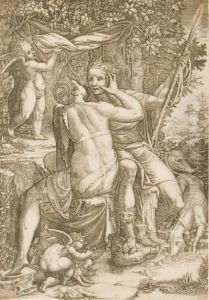Teodoro M. Ghisi Paintings
Teodoro M. Ghisi, also known as Teodoro Ghisi or simply Teodoro Mantovano, was an Italian engraver and painter of the Renaissance period. Born in 1536 in Mantua, Italy, he was part of a family of artists; his brother Giorgio Ghisi was also a renowned engraver. Teodoro's work was significantly influenced by the artistic environment of Mantua, which was a vibrant cultural center during the Renaissance.
Ghisi's early training is not well-documented, but it is believed that he was initially instructed by his elder brother Giorgio. He later may have studied with other Mantuan artists, such as Giulio Romano, who was a prominent painter and architect in the city. Teodoro's style suggests that he was also influenced by the works of other Italian masters like Raphael and Michelangelo, whose works were widely admired and studied during that time.
While Teodoro Ghisi did produce some paintings, he is primarily known for his engravings. His engravings are characterized by their fine lines and attention to detail, which reveal a mastery of the engraving technique. Many of his works were reproductions of famous paintings by other artists, a common practice at the time that helped disseminate the designs of leading painters to a broader audience. These engravings also served as a source of income for engravers like Ghisi, as they were in demand among collectors and art lovers who could not afford or access the original paintings.
Throughout his career, Teodoro Ghisi contributed to the spread of the Italian Renaissance style across Europe. His works reflect the classical themes and humanist ideals that were central to the Renaissance movement. Ghisi's engravings were not only works of art but also important documents of the artistic achievements of the period.
Teodoro M. Ghisi's contributions to art were recognized in his time, and his works continue to be studied by art historians and enthusiasts. He passed away in 1601, leaving behind a legacy of engravings that continue to be appreciated for their beauty and historical significance.
